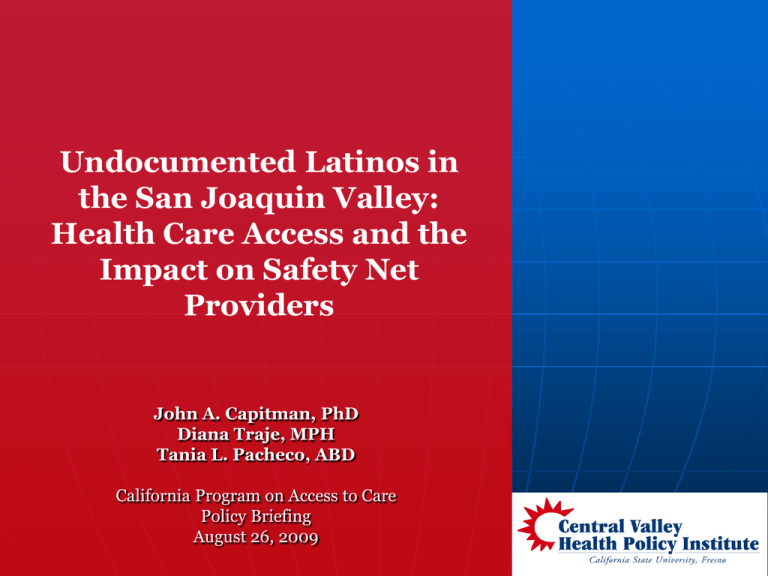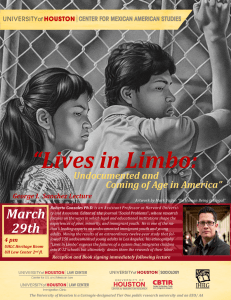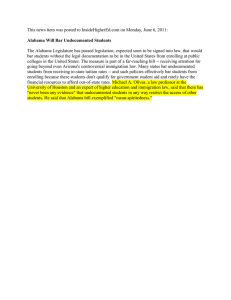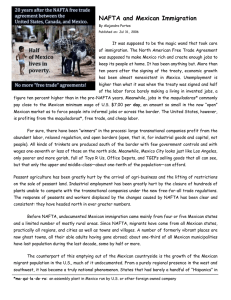Undocumented Latinos in the San Joaquin Valley: Health Care Access and the
advertisement

Undocumented Latinos in the San Joaquin Valley: Health Care Access and the Impact on Safety Net Providers John A. Capitman, PhD Diana Traje, MPH Tania L. Pacheco, ABD California Program on Access to Care Policy Briefing August 26, 2009 Overview Background Study methods Findings Policy recommendations Purpose of Study The purpose of this study is to assess how safety net providers are impacted by serving undocumented Latinos and how immigrant populations are experiencing care access California Undocumented Population Rates of recently arrived foreign-born, 2005 10000 9000 Rate per 100,000 8000 7000 6000 5000 4000 3000 2000 1000 0 Southern CA (1,922,917) Source: California Research Bureau San Joaquin Valley (280,745) Bay Area (195,847) San Joaquin Valley San Joaquin Valley Mexican Population Non-citizen 24% Naturalized 10% US Born 66% Source: CHIS, 2005, 2007 Federal Poverty Level 80% 73% 70% 60% 54% 50% 47% 44% US Born Mexican Naturlaized Mexican 40% 30% 34% Non Citizen Mexican 29% 28% US Born White 25% 22% 18% 20% 17% 9% 10% 0% 0-99% Source: CHIS, 2005, 2007 100-199% >=200% Education Level 70% 62% 60% 55% 50% 41% 40% US Born Mexican Naturalized Mexican 30% 27% 19% 20% 10% 15% 9% Non Citizen Mexican 24% US Born White 17% 13% 12% High School >High School 8% 0% <High School Source: CHIS, 2005, 2007 Self-reported Health Status 45% 39% 40% 41% 35% 35% 31% 28% 29% 30% 28% 27% 25% 25% US Born Mexican 23% Naturalized Mexican 20% Non Citizen Mexican 13% 15% 12% 11% 10% 5% 10% 11% 13% 12% 7% 4% 3% 0% Poor Source: CHIS, 2005, 2007 Fair Good Very Good Excellent US Born White Health Insurance Coverage 100% 90% 80% 91% 88% 73% 70% 60% 52% US Born Mexican Naturlaized Mexican 50% Non Citizen Mexican 40% US Born White 30% 20% 10% 0% % with Health Insurance Source: CHIS, 2005, 2007 California Policy Context Health care coverage for the undocumented • County programs for medically indigent Discretionary funding levels, eligibility requirements, and services provided • County Medical Services Program (CMSP) • Medically Indigent Service Programs (MISP) California Policy Context Health care coverage for the undocumented • Medi-Cal Undocumented are not eligible for full-scope Undocumented are eligible for: • Emergency Medi-Cal; Pregnancy only Medi-Cal • Emergency Medical Treatment and Labor Act Medicare participating hospitals must examine or treat patients’ emergency medical conditions regardless of an individual's ability to pay and citizenship Hospitals are required to provide stabilizing treatment for patients California Policy Context Mixed-status families • While parents may not qualify for programs, their children may be eligible Medi-Cal Child Health and Disability Prevention program California Children Services Program Healthy Families Insurance Healthy Kids Insurance Kaiser Permanente Child Health Plan Recent state health care budget cuts • Children with mixed-status families could be shut off from Healthy Families along with other U.S.-born children due to state cuts What is the impact of serving undocumented patients on San Joaquin Valley safety net providers and how are immigrant groups experiencing care access? Study Methods Provider Perspectives Telephone, in-person and electronic interviews with administrators/ representatives from 12 health care provider organizations in the San Joaquin Valley • Public and private hospitals, rural health clinics, federally qualified health centers, and county clinic systems Interview questions • Volume of undocumented individuals accessing care through the safety net system • Types of services used; impact on clinic/emergency services capacity • Costs of services provided • Percentage of bad debt and/or charity write-offs directly attributable to services provided to undocumented immigrants Study Methods Patient Perspectives 2 Promotoras Studies • Studies used CHWs as promoters of health care access • Intervention through referrals, follow up calls, or home visits • Success was measured through a three-month follow up survey and interviews with Promotoras • Access Indicators: 1) increasing enrollment in health insurance programs 2) receipt of preventive care services, 3) establishing a usual source of care, and 4) improve self-efficacy Study Methods Patient Perspectives Hmong Study • 170 interviews were conducted in Hmong and English • Questions included: demographics, personal health and health behaviors, cultural and western health care practices, and prenatal health care Immigrant Advocacy Groups • Interviews with representatives from 2 immigrant advocacy groups • Provided additional information on the health care experiences of undocumented Latinos Findings Provider Perspectives Providers generally do not collect information on patients’ citizenship status, therefore, the number of undocumented immigrants using health services and the financial costs associated with treating them are unknown. Some providers reported a decrease in the number of undocumented Latino immigrants due to a reduction/ loss of employment in agricultural and construction jobs, but this perspective was not universal. Findings Provider Perspectives Providers reported an increase in the overall number of uninsured populations attributable to unemployment and discontinuous enrollment in public programs. • Providers are placing new emphasis on qualifying uninsured patients for federal, state, and county programs that offer reimbursements. • Since these providers serve relatively more Medi-Cal beneficiaries, low reimbursements are an ongoing concern. Levels of uncompensated care have increased for all of the providers interviewed. As a result, providers are focusing on operational efficiencies and improving cash flow. • One provider discussed stepping up collections processes. Several providers are requiring payments up front or proof that the patient is able to pay for services. Findings Provider Perspectives Providers working with programs to address access for low-income and uninsured Local Children’s Health Initiatives- enrolls children into health insurance programs (federal, state and local) Health Initiative of the Americas- coordinates the availability of health resources for Mexican immigrants families through bilateral training, research, and health promotion activities Central Valley Health Network- A consortium of 13 Federally Qualified Health Center’s throughout the Central Valley • Provides advocacy, training, technical assistance, resource development, and program administration • Focuses on critical issues affecting members and their patients’ access to health care Findings Patient Perspectives Among Hmong residents, higher rates of insurance coverage but low rates of primary care Perceived value of Western health care and perceived cultural disrespect were key determinants of use Participant Quote “The doctors must have knowledge of the Hmong culture and beliefs in order to understand how to help the patient.” Findings Patient Perspectives Fear of being reported, navigating a complex health system, and language barriers exist when seeking care Waiting lists and stringent requirements block access Patient Quote “…for my people who do not know where or with whom to go with, or those of us who do not understand-we are scared of immigration agents.” Findings Patient Perspectives Citizens and Residents Undocumented • 45% of our respondents were uninsured at baseline • At follow-up, they were enrolled into Medicare, Medi-Cal, or a private insurance • Large majority (90% in our sample) uninsured, others rely on MedicalEmergency or buy meds at local pharmacy • Very few can afford private insurance(2%) • At follow-up, 20% had health insurance • Others who could not be enrolled were referred to sliding-scale fee clinics Findings Patient Perspectives Promotoras improve coverage and access for Latino’s Undocumented parents were happy to get coverage for kids, though they could not qualify for coverage Promotora Quote “[The Intervention] made them more confident, the fact that we were able to give them a sense of security in case they had a question.” Participant Quote “It's good to feel that your children have health insurance in case they get sick.” Policy Recommendations Long-term sustainability plan for safety net providers Supplemental federal funding for services provided to the undocumented and uninsured Addressing cultural barriers to health care by holding providers accountable for meeting the CLAS standards Policy Recommendations Institutionalizing community health workers/ promotores de salud by developing certification programs and specific reimbursements Include undocumented in national health reform plans Target health care access assistance to children in mixed-status households Acknowledgments We would like to thank our funders California Program on Access to Care • Safety net provider study Centers for Medicare and Medicaid Services Hispanic Health Services Research Grant Program and the Kaiser Permanente Fresno Community Benefits Program • Promotora studies The California Endowment • Hmong health study Contact Central Valley Health Policy Institute www.cvhpi.org John A. Capitman jcapitman@csufresno.edu (559) 228-2157


![The UNC Policy Manual 700.1.4[G] Adopted 11/12/2004 Amended 07/01/07](http://s2.studylib.net/store/data/012014973_1-6dab9e811fb276e7cbea93f611ad7cd8-300x300.png)
